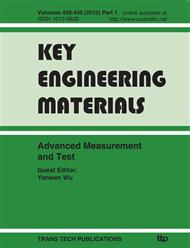[1]
Y.X. LUO. The gray model and method of test data processing & online monitoring of trial (in Chinese). Journal of Chinese Machine Design, Vol. 10, No. 6(1993), pp.38-41.
Google Scholar
[2]
Guan J. H., Li D. H., Shi Y. H., Cai T. Study on the Gray Model for the Measurement in Honing Process of Cylinder Bore of Engine . Advances in Systems Science and Applications, Vol. 3, No. 4(2003), pp.531-536.
Google Scholar
[3]
Xiong H. J., Chen D. J., Chen M. Y. Study on Gray Method of Data Mining. Advances in Systems Science and Applications, Vol. 3, No. 2(2003), pp.309-313.
Google Scholar
[4]
Z.M. HE, Y.X. LUO. Gray model and method of computer aided line-drawing data processing (in Chinese). Transactions of the Chinese Society for Agricultural Machinery, Vol. 33, No. 2, (2002), pp.94-96.
Google Scholar
[5]
Y. X LUO., L.T. ZHANG,A.H. CAI et al. Grey GM(1, 1) with function-transfer method and application to energy consuming prediction. Kybernets, Vol. 33, No. 2(2004), pp.322-330.
Google Scholar
[6]
Y.X. LUO, D.G. LIAO, Q. X TANG et al. A Step by Step Optimum Modeling method of GM (1, 1) and Its Application to Fault Diagnosis in NC System of NC Machine Tool. Machine tool & Hydraulics, No. 6(2002), pp.229-231.
Google Scholar
[7]
Y.X. LUO L.T. ZHANG, M. LI. Grey system theory and its application to mechanical engineering (in Chinese). ShangSha: National University of Defense technology Press (2001).
Google Scholar
[8]
S.F. LIU,T.B. GUO,Y.G. DANG, et al. Grey systems and Applications (third edtion)(in Chinese) . Beijing: China Science Press (2004).
Google Scholar
[9]
Y.X. LUO, M. LI, X.F. LI, et al. . Method and grey GM (1, N) model of line-drawing data processing in computer aided design. Transactions of the Chinese Society for Agricultural machinery, Vol. 34, No. 2(2003), pp.94-96.
Google Scholar
[10]
Q.Y. WANG. Uncertainty mathematical model of forecast & decision-making (in Chinese). Beijing: Metallurgical industry Press (2001).
Google Scholar
[11]
Dong Hwa Kim, Ajith Abraham, Jae Hoon Cho. A Hybrid Genetic Algorithm and Bacterial Foraging Approach for Global Optimization"(in Chinese), Information Sciences, 177(2007), pp.3918-3937.
DOI: 10.1016/j.ins.2007.04.002
Google Scholar
[12]
K. Guney, S. Basbug, Interference Suppression of Linear Antenna Arrays by Amplitude-only Control Using a Bacterial Foraging Algorithm, Progress In Electromagnetics Research, 2008. PIER 79, pp.475-497.
DOI: 10.2528/pier07110705
Google Scholar
[13]
Z.G. CHEN, Y.X. LUO, Y.H. CAOptimization for PID Control Parameters on Hydraulic Servo Control System Based on Bacterial Foraging Oriented by Particle Swarm Optimization. The International Conference on Information Engineering and Computer Science (ICIECS2009), 2009, Wuhan, pp.562-565.
DOI: 10.1109/iciecs.2009.5363433
Google Scholar


